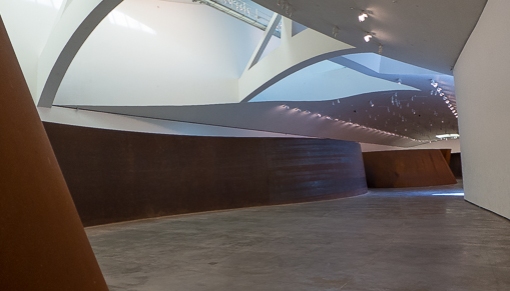We spent a few days in Madrid after Donostia-San Sebastián. The Museo Nacional del Prado had just put on a special exhibition that marked the 5th centenary of the death of Jheronimus Bosch – aka El Bosco.

This represents the greatest number of Bosch’s works ever to be assembled.

Each ticket entitled one to enter the gallery at a set time (our time slot was 18:30). It was indeed a special treat. Bosch’s most important triptychs were shown free-standing in order for both the fronts and backs to be visible.

Photography was not allowed in the gallery. What you are seeing here are printed cardboard tiles of The Garden of Earthly Delights Triptych (El jardín de las delicias), center panel, hence the white dots. The museum sells a reproduction of this painting in the form of a set of tiles that can be hung on the wall. These pictures are taken from a set that was hanging near the entrance of the museum shop.

Some of the text below came from an interactive storyboard on the Prado’s website, click here to see it – it is illustrated with several other paintings by El Bosch.

Jheronimus Bosch was born around 1450 in the town of ’s-Hertogenbosch. He took the surname of Bosch from the last syllable of the city’s name. His real name was Jheronimus van Aken.

In his paintings, Bosch represented the obsessions and anxieties of men and women of his own time in a masterly manner. All details were carefully planned by the painter and are seemingly meaningful.

His work is known for its fantastic imagery, detailed landscapes, and illustrations of religious concepts and narratives. The theatre had a notable influence on Bosch’s work. Many of his paintings are organized in the manner of stage sets.

Bosch’s imagery struck a chord with Joan Miró and Salvador Dalí.

Apparently René Magritte and Max Ernst both were inspired by Bosch’s The Garden of Earthly Delights.

Moralists during Bosch’s era believed that it was woman’s—ultimately Eve’s—temptation that drew men into a life of sin. There are 31 females in the central pool surrounded by about 100 males performing stunts while riding on fancy animals in an endless, circular path.

Some critics have interpreted the triptych as a warning on the transience of earthly pleasure. Based a medieval mindset, the sumptuousness of Bosch’s description may have been intended to convey a false paradise, filled with transient beauty.
The general consensus is that his art reflects the orthodox religious belief systems of his age.

Another interpretation posits that the triptych’s center panel portrays a joyous world when humanity will experience a rebirth of the innocence enjoyed by Adam and Eve before their fall.

The exhibition showed studies based on infra-red and X-ray which reveal the creative process showing the surprising changes that Bosch made between the start of the under-drawing and the completion of the pictorial surface.

Bosch enjoyed enormous success in his lifetime and his works were regularly copied and faked. Most of his work were destroyed during the Protestant Reformation. Attribution has been especially difficult; today only about 25 paintings are confidently given to his hand along with 8 drawings.

































































 .
.





























